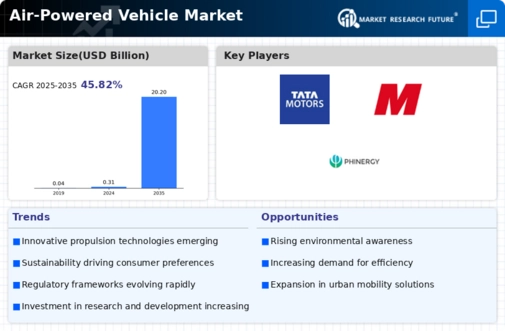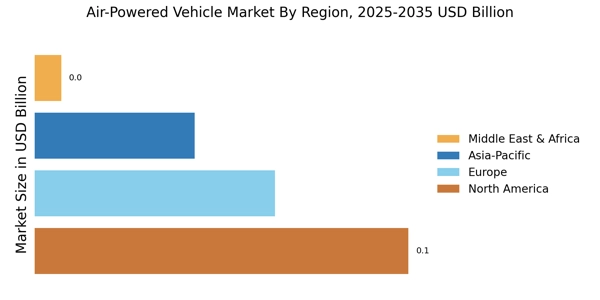The Air-Powered Vehicle Market is currently characterized by a dynamic competitive landscape, driven by technological advancements and a growing emphasis on sustainability. Major players such as Airbus (France), Boeing (United States), and Toyota (Japan) are at the forefront, each adopting distinct strategies to enhance their market positioning. Airbus (France) focuses on innovation through its development of hybrid air vehicles, while Boeing (United States) emphasizes partnerships with tech firms to integrate advanced AI systems into their aircraft. Toyota (Japan) is leveraging its expertise in hydrogen fuel technology to explore air-powered vehicles, indicating a strategic pivot towards cleaner energy solutions. Collectively, these strategies not only enhance their competitive edge but also contribute to a rapidly evolving market environment.
In terms of business tactics, companies are increasingly localizing manufacturing to reduce costs and improve supply chain efficiency. This trend is particularly evident in the Air-Powered Vehicle Market, which appears to be moderately fragmented, with several key players vying for dominance. The collective influence of these companies shapes a competitive structure that encourages innovation and collaboration, as firms seek to differentiate themselves through unique technological offerings and sustainable practices.
In August 2025, Boeing (United States) announced a strategic partnership with a leading AI firm to develop autonomous flight systems for air-powered vehicles. This move is significant as it positions Boeing to capitalize on the growing demand for automation in aviation, potentially enhancing safety and operational efficiency. The integration of AI could also streamline maintenance processes, thereby reducing operational costs and improving service reliability.
In September 2025, Toyota (Japan) unveiled its latest prototype of an air-powered vehicle that utilizes hydrogen fuel cells, showcasing its commitment to sustainable transportation solutions. This development is crucial as it aligns with global trends towards reducing carbon emissions and highlights Toyota's strategic focus on innovation in the air mobility sector. The prototype's successful testing could pave the way for commercial applications, further solidifying Toyota's position in the market.
In October 2025, Airbus (France) launched a new initiative aimed at enhancing the sustainability of its air-powered vehicles by incorporating recycled materials into their manufacturing processes. This initiative not only reflects Airbus's commitment to environmental stewardship but also positions the company as a leader in sustainable aviation practices. By prioritizing eco-friendly materials, Airbus may attract environmentally conscious consumers and stakeholders, thereby enhancing its competitive advantage.
As of October 2025, the Air-Powered Vehicle Market is witnessing trends that emphasize digitalization, sustainability, and the integration of AI technologies. Strategic alliances among key players are increasingly shaping the competitive landscape, fostering innovation and collaboration. Looking ahead, it is likely that competitive differentiation will evolve, shifting from traditional price-based competition to a focus on technological innovation, reliability in supply chains, and sustainable practices. This transition may redefine market dynamics, compelling companies to adapt and innovate continuously.


















Leave a Comment